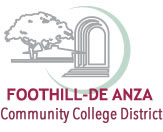The Foothill-De Anza Community College District is following current guidance from Santa Clara County and California health authorities, which is summarized on this webpage.
Click each link below to learn what you need to do, if you have
- a respiratory virus such as COVID-19, influenza (flu) or respiratory syncytial virus (RSV)
- a positive test result for a respiratory virus but no symptoms
- or close contact with someone who has a respiratory virus
The information on this webpage has been updated to align with new recommendations issued Sept. 17, 2024 by the Santa Clara County Department of Public Health. These recommendations cover all respiratory viruses including COVID-19, influenza (flu) or respiratory syncytial virus (RSV).
Reporting COVID-19
- Employees who test positive for COVID-19 are required to notify the district by completing the online employee self-reporting form.
- Students who test positive for COVID-19 are encouraged, but not required, to submit the student self-reporting form. Your report will help us keep track of exposures and may reduce the risk of further spreading.
If you have a respiratory virus and have symptoms:
- Stay home and avoid others, including people you live with if they're not sick
- You can resume normal activities when
- You have been fever-free for 24 hours without using fever-reducing medicine,
and - Your other symptoms are improving
- When you resume normal activities, you should take these precautions for the next 5 days:
- Wear a mask that covers your nose and mouth when you're around other people indoors
- Get tested for respiratory viruses to find out if you are still infected
- Take steps to ensure that there is good air circulation around you
- Follow good hygiene – wash your hands frequently, cover your mouth and nose when coughing or sneezing
- Maintain physical distance from other people
- If you develop a fever or feel worse after you resume activities, repeat Steps 1-3 above.
If you have a positive test resultfor respiratory virus, but never develop symptoms:
- You may still be contagious
- Take these precautions for 5 days:
- Wear a mask that covers your nose and mouth when you're around other people indoors
- Get tested for respiratory viruses to find out if you are still infected
- Take steps to ensure that there is good air circulation around you
- Follow good hygiene – wash your hands frequently, cover your mouth and nose when coughing or sneezing
- Maintain physical distance from other people
- If you develop a fever or other symptoms, follow the recommendations listed on this page for "Respiratory Virus With Symptoms"
If you learn that you've had close contactwith someone who has a respiratory virus:
- If you're in a higher-risk group, you should get tested for respiratory viruses within 5 days after exposure
- If you test positive, follow the recommendations on this page for either "Respiratory Virus With Symptoms" or "Positive Test But No Symptons" – depending on your circumstance.
If you are around people who are at higher-risk for severe illness
- Consider getting tested for respiratory viruses
- Wear a mask indoors for 5 days after exposure
- If you test positive, follow the recommendations on this page for either "Respiratory Virus With Symptoms" or "Positive Test But No Symptons" – depending on your circumstance.
Notes and Definitions
What are the symptoms of respiratory virus?
Symptoms can include: fever or chills, cough, runny or stuffy nose, headache.
Additional symptoms may include (but are not limited to): chest discomfort, sore throat, sneezing, wheezing, muscle or body aches, decreased appetie, diarrhea, vomiting, new loss of taste or smell.
How can I get tested for respiratory virus?
There are separate tests for COVID-19, flu and RSV. You can learn more about the testing options by visiting the California Department of Public Health webpage on respiratory viruses – scroll down to the section headed "Smarter Steps for Virus Protection"
How do you count days for isolation?
Day 0 is the day you first experience symptoms, provide a sample that produces a positive test result, or have close contact with someone who has a respiratory virus. Day 1 is the first full day after that. For example, if you test positive on Monday, then Tuesday is Day 1, and so forth.
What does "close contact" mean?
For smaller indoor spaces (such as homes, waiting rooms or airplanes), close contact means being in that space for a total of at least 15 minutes during a 24-hour period with someone who has tested positive for respiratory virus and has symptoms.
For larger indoor spaces (such as large stores, warehouses or indoor concert venues), close contact means being within six feet for a total of at least 15 minutes during a 24-hour period with someone who has tested positive for respiratory virus and has symptons.
This can include multiple short-duration exposures that add up to at least 15 minutes.
Who is considered at "higher risk" for respiratory viruses?
This includes the elderly, residents of group care facilities and people with weak immune systems or other vulnerable conditions.
When is someone with a respiratory virus potentially contagious?
A person who has a respiratory virus can be contagious for 5 days or longer after they become sick or test positive, according to the Santa Clara County Department of Public Health.
